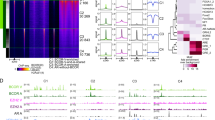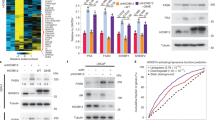Abstract
Prostate cancers (PCs), initially responsive to anti-androgen therapies, often advance to a hormone-refractory ‘castrate-resistant’ PC (CRPC) stage. However, the androgen receptor (AR) pathway remains active and key for cell growth and gene expression within tumours, even in the apparent absence of hormone. Proposed mechanisms to explain progression, including AR amplification/mutation, are insufficient to completely explain CRPC and possible roles of AR cofactors such as prohibitin (PHB) are poorly understood. We investigated whether PHB loss could sensitise PC cells and tumours to adrenal gland-derived androgens, which persist even after androgen ablation, hence contribute to development of CRPC. Using a pair of PC cell lines, inducibly expressing ectopic cDNA or RNAi for PHB, responses to different androgens and hormone concentrations were studied both in vitro and in vivo. PHB was found at the promoters of several genes, both AR and non-AR-regulated, and knockdown increased histone acetylation at these promoters. Further, PHB knockdown increased the rate of AR ligand-induced chromatin binding, and binding rate and occupancy of AR upon the PSA promoter. This resulted in increased cell growth and AR activity in response to all androgens, including promoting a response to the weaker adrenal androgens previously absent at physiological concentrations. In vivo this had functional consequences such that PHB knockdown resulted in androstenedione being sufficient to promote tumour growth, under conditions mimicking those in patients undergoing androgen ablation therapy. We conclude that reduction in PHB levels is sufficient to lower the threshold of AR activity in vitro and in vivo; this may be via a general increase in histone acetylation that could potentially affect signalling by other transcription factors. PHB loss may provide a mechanism for progression to CRPC by sensitising PC cells to ‘castrate’ conditions—that is, low levels of testicular androgens in the continued presence of weak adrenal and dietary androgens.
This is a preview of subscription content, access via your institution
Access options
Subscribe to this journal
Receive 50 print issues and online access
$259.00 per year
only $5.18 per issue
Buy this article
- Purchase on Springer Link
- Instant access to full article PDF
Prices may be subject to local taxes which are calculated during checkout







Similar content being viewed by others
References
Ferlay J, Autier P, Boniol M, Heanue M, Colombet M, Boyle P . Estimates of the cancer incidence and mortality in Europe in 2006. Ann Oncol 2007; 18: 581–592.
Kokontis JM, Liao S . Molecular action of androgen in the normal and neoplastic prostate. Vitam Horm 1999; 55: 219–307.
Jenster G . The role of the androgen receptor in the development and progression of prostate cancer. Semin Oncol 1999; 26: 407–421.
Tsai M-J, O’Malley B . Molecular mechanisms of action of steroid/thyroid receptor superfamily members. Annu Rev Biochem 1994; 63: 451–486.
Brinkmann AO, Trapman J . Prostate cancer schemes for androgen escape. Nat Med 2000; 6: 628–629.
Isaacs JT, Isaacs WB . Androgen receptor outwits prostate cancer drugs. Nat Med 2004; 10: 26–27.
Brooke GN, Bevan CL . The role of androgen receptor mutations in prostate cancer progression. Curr Genomics 2009; 10: 18–25.
Evans RM . The steroid and thyroid hormone receptor superfamily. Science 1988; 240: 889–895.
Tsai MJ, O’Malley BW . Molecular mechanisms of action of steroid/thyroid receptor superfamily members. Annu Rev Biochem 1994; 63: 451–486.
Brinkmann AO . Molecular basis of androgen insensitivity. Mol Cell Endocrinol 2001; 179: 105–109.
Brinkmann AO, Trapman J . Prostate cancer schemes for androgen escape. Nat Med 2000; 6: 628–629.
Isaacs JT, Isaacs WB . Androgen receptor outwits prostate cancer drugs. Nat Med 2004; 10: 26–27.
Gamble SC, Chotai D, Odontiadis M, Dart DA, Brooke GN, Powell SM et al. Prohibitin, a protein downregulated by androgens, represses androgen receptor activity. Oncogene 2007; 26: 1757–1768.
Gamble SC, Odontiadis M, Waxman J, Westbrook JA, Dunn MJ, Wait R et al. Androgens target prohibitin to regulate proliferation of prostate cancer cells. Oncogene 2004; 23: 2996–3004.
Nijtmans LG, Artal SM, Grivell LA, Coates PJ . The mitochondrial PHB complex: roles in mitochondrial respiratory complex assembly, ageing and degenerative disease. Cell Mol Life Sci 2002; 59: 143–155.
Rajalingam K, Wunder C, Brinkmann V, Churin Y, Hekman M, Sievers C et al. Prohibitin is required for Ras-induced Raf-MEK-ERK activation and epithelial cell migration. Nat Cell Biol 2005; 7: 837–843.
Coates PJ, Jamieson DJ, Smart K, Prescott AR, Hall PA . The prohibitin family of mitochondrial proteins regulate replicative lifespan. Curr Biol 1997; 7: 607–610.
McClung JK, Jupe ER, Liu XT, Dell’Orco RT . Prohibitin: potential role in senescence, development, and tumor suppression. Exp Gerontol 1995; 30: 99–124.
Choi D, Lee SJ, Hong S, Kim IH, Kang S . Prohibitin interacts with RNF2 and regulates E2F1 function via dual pathways. Oncogene 2008; 27: 1716–1725.
Wang S, Fusaro G, Padmanabhan J, Chellappan SP . Prohibitin co-localizes with Rb in the nucleus and recruits N-CoR and HDAC1 for transcriptional repression. Oncogene 2002; 21: 8388–8396.
He B, Feng Q, Mukherjee A, Lonard DM, DeMayo FJ, Katzenellenbogen BS et al. A repressive role for prohibitin in estrogen signaling. Mol Endocrinol 2008; 22: 344–360.
Fusaro G, Dasgupta P, Rastogi S, Joshi B, Chellappan S . Prohibitin induces the transcriptional activity of p53 and is exported from the nucleus upon apoptotic signaling. J Biol Chem 2003; 278: 47853–47861.
Wang S, Zhang B, Faller DV . BRG1/BRM and prohibitin are required for growth suppression by estrogen antagonists. Embo J 2004; 23: 2293–2303.
Dai Y, Ngo D, Jacob J, Forman LW, Faller DV . Prohibitin and the SWI/SNF ATPase subunit BRG1 are required for effective androgen antagonist-mediated transcriptional repression of androgen receptor-regulated genes. Carcinogenesis 2008; 29: 1725–1733.
Rastogi S, Joshi B, Dasgupta P, Morris M, Wright K, Chellappan S . Prohibitin facilitates cellular senescence by recruiting specific corepressors to inhibit E2F target genes. Mol Cell Biol 2006; 26: 4161–4171.
Eissenberg JC, Elgin SC . The HP1 protein family: getting a grip on chromatin. Curr Opin Genet Dev 2000; 10: 204–210.
Dart DA, Spencer-Dene B, Gamble SC, Waxman J, Bevan CL . Manipulating prohibitin levels provides evidence for an in vivo role in androgen regulation of prostate tumours. Endocr Relat Cancer 2009; 16: 1157–1169.
Pignatelli D, Xiao F, Gouveia AM, Ferreira JG, Vinson GP . Adrenarche in the rat. J Endocrinol 2006; 191: 301–308.
van Weerden WM, Bierings HG, van Steenbrugge GJ, de Jong FH, Schroder FH . Adrenal glands of mouse and rat do not synthesize androgens. Life Sci 1992; 50: 857–861.
de la Torre B, Benagiano G, Diczfalusy E . Pathways of testosterone synthesis in decapsulated testes of mice. Acta Endocrinologica 1976; 81: 170–184.
Feek CM, Tuzi NL, Edwards CR . The adrenal gland and progesterone stimulates testicular steroidogenesis in the rat in vivo. J Steroid Biochem 1989; 32: 573–579.
Mullins LJ, Peter A, Wrobel N, McNeilly JR, McNeilly AS, Al-Dujaili EA et al. Cyp11b1 null mouse, a model of congenital adrenal hyperplasia. J Biol Chem 2009; 284: 3925–3934.
Min W, Pober JS, Johnson DR . Kinetically coordinated induction of TAP1 and HLA class I by IFN-gamma: the rapid induction of TAP1 by IFN-gamma is mediated by Stat1 alpha. J Immunol 1996; 156: 3174–3183.
Joshi B, Rastogi S, Morris M, Carastro LM, DeCook C, Seto E et al. Differential regulation of human YY1 and caspase 7 promoters by prohibitin through E2F1 and p53 binding sites. Biochem J 2007; 401: 155–166.
Kang Z, Pirskanen A, Janne OA, Palvimo JJ . Involvement of proteasome in the dynamic assembly of the androgen receptor transcription complex. J Biol Chem 2002; 277: 48366–48371.
Kang Z, Janne OA, Palvimo JJ . Coregulator recruitment and histone modifications in transcriptional regulation by the androgen receptor. Mol Endocrinol 2004; 18: 2633–2648.
Metivier R, Penot G, Hubner MR, Reid G, Brand H, Kos M et al. Estrogen receptor-alpha directs ordered, cyclical, and combinatorial recruitment of cofactors on a natural target promoter. Cell 2003; 115: 751–763.
Shi SL, Li QF, Liu QR, Xu DH, Tang J, Liang Y et al. Nuclear matrix protein, prohibitin, was down-regulated and translocated from nucleus to cytoplasm during the differentiation of osteosarcoma MG-63 cells induced by ginsenoside Rg1, cinnamic acid, and tanshinone IIA (RCT). J Cell Biochem 2009; 108: 926–934.
Chen F, Knecht K, Leu C, Rutledge SJ, Scafonas A, Gambone C et al. Partial agonist/antagonist properties of androstenedione and 4-androsten-3beta,17beta-diol. J Steroid Biochem Mol Biol 2004; 91: 247–257.
Jia L, Coetzee GA . Androgen receptor-dependent PSA expression in androgen-independent prostate cancer cells does not involve androgen receptor occupancy of the PSA locus. Cancer Res 2005; 65: 8003–8008.
Zhang L, Johnson M, Le KH, Sato M, Ilagan R, Iyer M et al. Interrogating androgen receptor function in recurrent prostate cancer. Cancer Res 2003; 63: 4552–4560.
Acknowledgements
We are grateful to members of the Androgen Signalling Laboratory for advice and technical help, to Ana Costa Pereira for the kind gift of TAP1 primers and interferon, and to Malcolm Parker for advice and critical reading of the manuscript. This work was supported by grants from the Hammersmith Hospital Special Trustees, the Medical Research Council of the UK, Cancer Research UK and The Prostate Cancer Charity.
Author information
Authors and Affiliations
Corresponding author
Ethics declarations
Competing interests
The authors declare no conflict of interest.
Additional information
Supplementary Information accompanies the paper on the Oncogene website
Supplementary information
Rights and permissions
About this article
Cite this article
Dart, D., Brooke, G., Sita-Lumsden, A. et al. Reducing prohibitin increases histone acetylation, and promotes androgen independence in prostate tumours by increasing androgen receptor activation by adrenal androgens. Oncogene 31, 4588–4598 (2012). https://doi.org/10.1038/onc.2011.591
Received:
Revised:
Accepted:
Published:
Issue Date:
DOI: https://doi.org/10.1038/onc.2011.591



